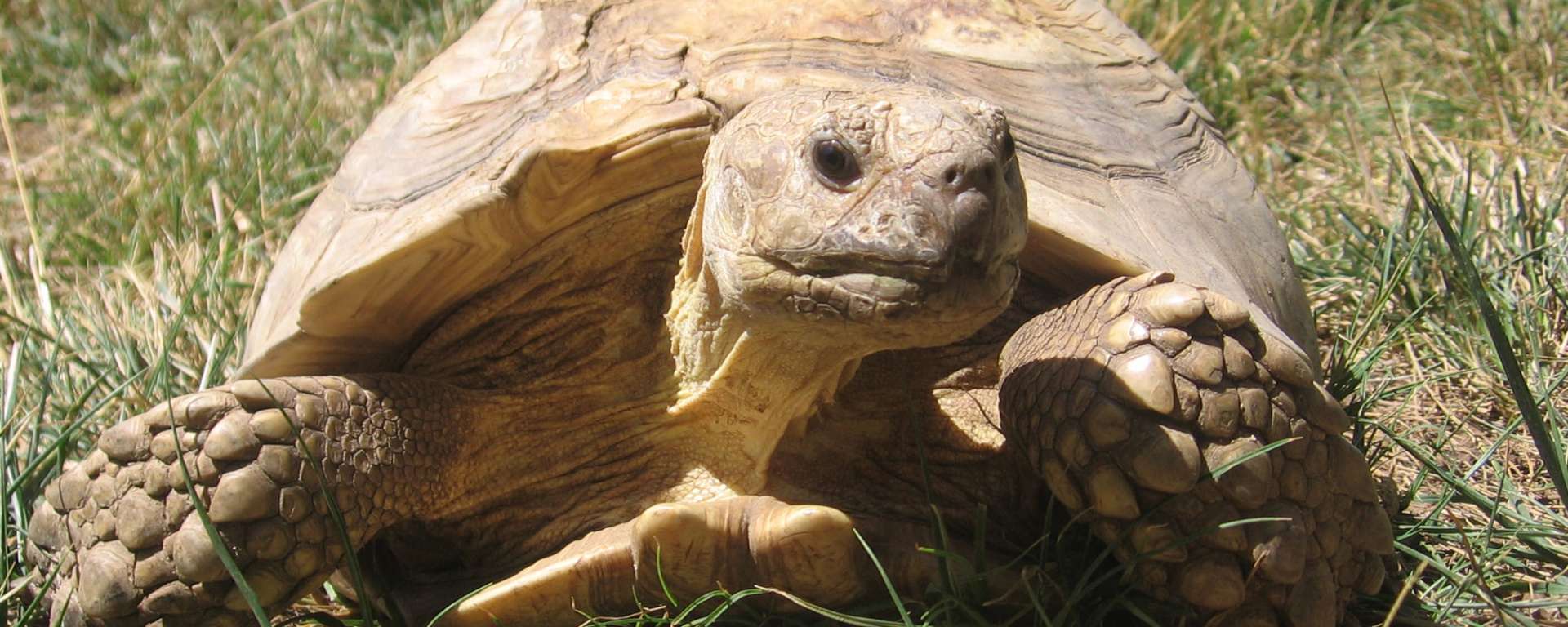Safari Spotlight: Sulcata Tortoise
Posted in: Safari Spotlight
Easter is nearly here and with it, that adorable little bunny who scampers about hiding easter eggs and trinkets for children to find. It would make sense then to focus this month’s Safari Spotlight on a rabbit or hare. Alas, the Safari West collection focuses much more on monkeys and hyenas than on the ubiquitous lagomorphs (the taxonomic order Lagomorpha contains rabbits, hares, and the mouse/rabbit-like pika). That being the case, for this round of the Spotlight, proudly standing in for the speedy hare will be its slow and steadfast companion, the tortoise.
More specifically, let’s discuss the sulcata tortoise. The sulcata tortoise, also known as the African spurred tortoise or spur-thighed tortoise (there are a lot of common names for this species), is a desert tortoise. They are found all along the southern edge of the Sahara desert in North Africa, an arid and inhospitable grassland that runs for thousands of miles across the span of Africa. We call this transition zone the Sahel. The sulcata is well adapted for life in the dry Sahelian climate. They are capable burrowers; a skill which allows them to dig down into cooler soils during the heat of the day. They are also able to survive with severe water restrictions. By capitalizing on the moisture content in their favorite food, grass, the sulcata tortoise is able to stay alive and hydrated in the absence of drinkable water.
Interesting for an animal living in an environment of limited resources, sulcata tortoises are large; very large. In fact, the sulcata tortoise is among the largest tortoises on the planet, capable of reaching over two and a half feet long and more impressively, weighing up to 230 pounds! With this great size comes a great deal of aggression as well. When you think aggressive, I doubt the tortoise is an animal that comes charging to mind, but in the sulcata’s case, it’s undeniably true. Male tortoises are known to fight viciously during the mating season, ramming one another repeatedly to the point of injury. If they can, sulcata males will try to flip over their opponents for a most humiliating defeat.
We have quite a few sulcata tortoises here at Safari West and they are a somewhat unique piece of our collection. For one, they are among the only reptiles we currently house. For another, they make up one of the few species who came to live here as part of a rescue program. By and large, Safari West is a breeding preserve focused on the conservation of endangered species. Sulcata tortoises are considered vulnerable by the International Union for the Conservation of Nature (IUCN) in large part because of increasing desertification and fragmentation of their natural habitat. We are not, however, breeding sulcatas at this time. The individuals who’ve made their home at Safari West are largely former pets, relinquished by their owners when they grew too large or became too sick.
Sulcatas do not make good pets for those two very legitimate reasons. As large, strong, willful animals, sulcatas can rapidly destroy a yard and are adept escape artists. Beyond that, they also require strict care, including a temperature appropriate habitat and a high-fiber diet consisting mainly of grasses. Well-meaning pet owners often unwittingly poison their tortoises with inappropriate local plants or else make them sick by feeding them soft fruits that we humans find delicious and nutritious. These dietary mistakes can result in tortoises with scars in the form of misshapen shells.
Happily, our sulcatas are hale and hearty and on warmer days, can be found rambling around many habitats here in the preserve. Come to Safari West this Easter and join us in the Hunt for the Hare. If you’re lucky, you may just turn up some tortoises too.


